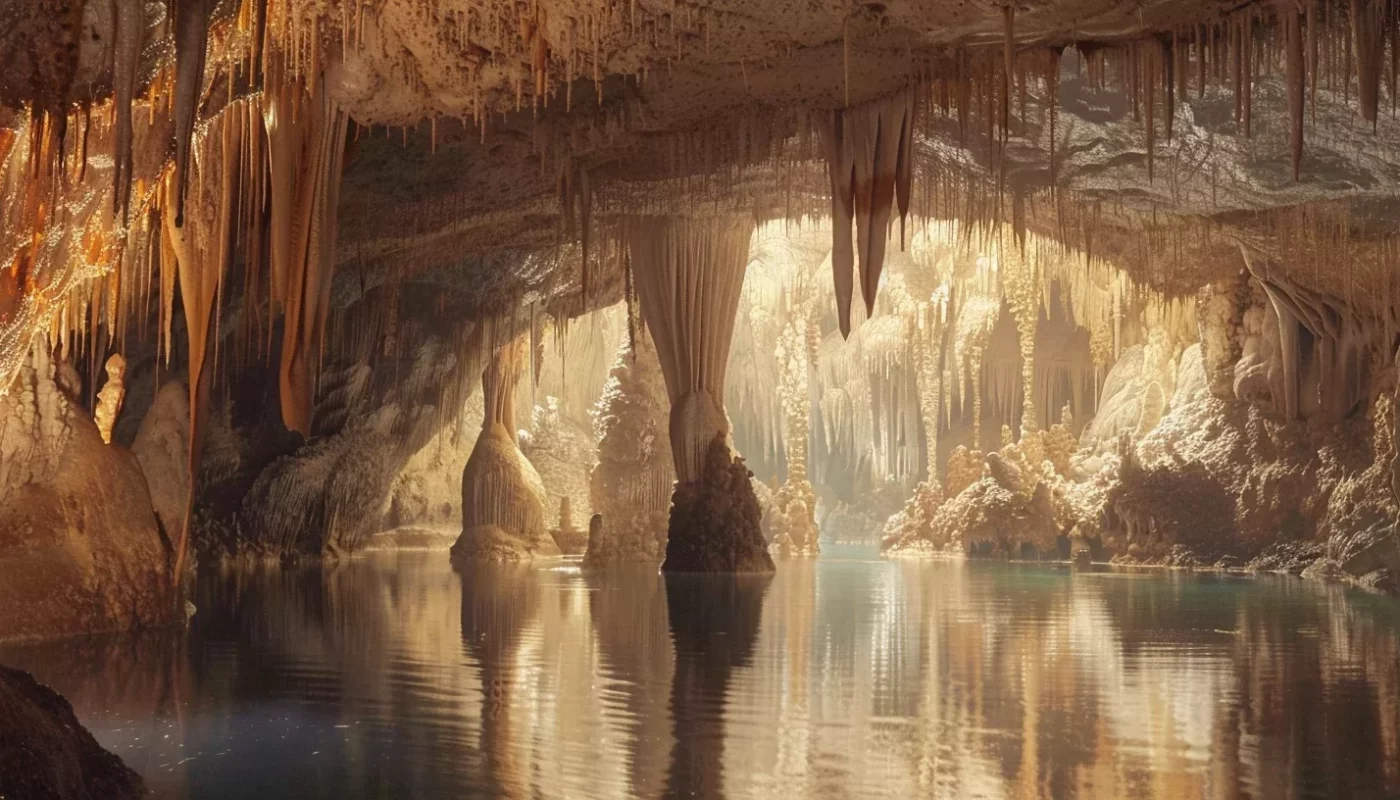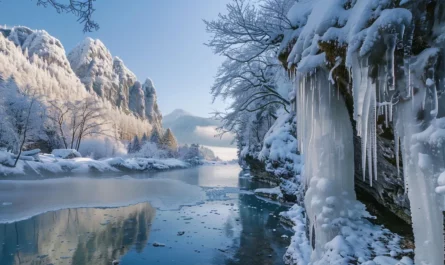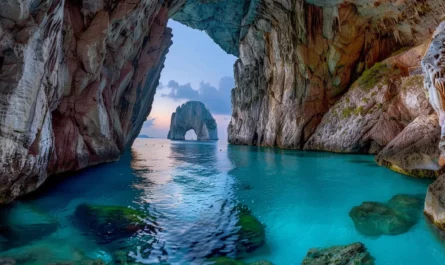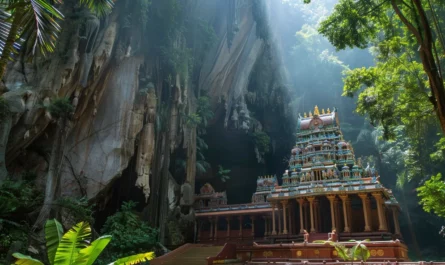Welcome to Mammoth Cave, the longest cave known, stretching 426 miles. It’s in Kentucky and draws many visitors yearly. Since the late 1950s, the Cave Research Foundation (CRF) has been key in mapping Mammoth Cave. Yet, the cave’s history dates even further back, with early American Indians exploring over 19 miles.
Important figures have shaped Mammoth Cave’s exploration. An enslaved guide, Stephen Bishop, greatly increased our knowledge of the cave in the 1840s. Additionally, the Hanson and Hunt families found new pathways in the 1930s.
In 1972, a crucial connection was made with the Flint Ridge Cave system, making Mammoth Cave the world’s longest known. This discovery linked to the Hanson’s Lost River, highlighting Mammoth Cave as a premier underground wonder.
Today, Mammoth Cave’s full size remains a mystery, drawing in explorers. The Cave Research Foundation, along with others, continues to map new areas. These efforts highlight the human drive for discovery and the vast hidden beauty underground.
Protecting Mammoth Cave is vital for its unique ecosystem and longevity. The Cave Research Foundation and Mammoth Cave National Park work together for this cause. They monitor the cave, manage visitors, and conduct studies to keep the cave’s delicate balance. This ensures an amazing visit for all, for generations to come.
Early Explorers of Mammoth Cave
Mammoth Cave’s exploration history dates back thousands of years. Beginning with Prehistoric American Indians around 5,000 years ago. They found more than 19 miles of passages.
“Mammoth Cave is a place of wonders. Its magnitude and grandeur are not easily described, nor its beauty adequately pictured.” – Stephen Bishop
In the 1840s, Stephen Bishop, an enslaved guide, worked at the cave and made it famous. His work added to the cave’s length and he drew one of the first maps. As more people visited the cave, he and fellow guides found new ways to explore it.
During the 1930s, the Hanson and Hunt families, known for guiding, found new parts of the cave. They located hidden spots and expanded what we knew about the cave’s pathways.
Stephen Bishop: A Pioneer in Cave Exploration
Stephen Bishop stands out in Mammoth Cave’s history. Even though he was enslaved, his deep knowledge of the cave was respected by many. He named important features like Frozen Niagara and his drawings helped us understand the cave.
The Hanson and Hunt Families: Descendants of Cave Exploration
Later, the Hanson and Hunt families’ work in the early 1900s continued the exploration tradition. They guided people and found new areas in the cave. Their efforts discovered hidden rooms and new formations, making the cave even more known.
Today, the work of these explorers is remembered. Because of them, new findings are still made in Mammoth Cave, inspiring more discovery.
| Early Explorers | Contributions |
|---|---|
| Prehistoric American Indians | Discovered over 19 miles of passages |
| Stephen Bishop | Extended the cave’s known length, created detailed maps |
| The Hanson and Hunt families | Explored “lost” passageways, discovered hidden chambers |
Connection Between Mammoth Cave and Flint Ridge Cave System
Before 1972, Flint Ridge Cave was known as the longest at 86.5 miles. Nearby, Mammoth Cave measured 57.9 miles. The explorers aimed to make Mammoth Cave the world’s longest known system.
During the 1950s and 1960s, some passageways were found, starting to link the caves. Yet, it wasn’t until 1972 that the big connection was achieved. Six brave spelunkers entered the unknown. They found the path to Hanson’s Lost River, proving the connection. This momentous discovery showed Mammoth Cave was indeed the longest known natural system.
This event was a huge deal in the caving world. It revealed the true vastness of caves beneath our feet. The link between Mammoth Cave and Flint Ridge still captures imagination. It gives a peek into Earth’s underground wonders.
Expanding Length of Mammoth Cave
Exploring Mammoth Cave is an ongoing adventure. It leads to finding new pathways and growing its length. The exact distance of the cave is a mystery, still being explored by adventurers. With each new area discovered, the cave’s size and beauty grow.
Dedicated groups like the Cave Research Foundation map the cave’s many passages. They add to our understanding of the cave, helping us know its current size is 426 miles (686 km). This work highlights the complex beauty hidden beneath our feet.
Mammoth Cave’s expansion shows the commitment of explorers. It’s also a clue to Earth’s incredible natural features. This wonderland captures the hearts of those eager to explore and learn.
As we keep exploring Mammoth Cave, its length will surely increase. The thrill of finding new places encourages explorers from all over. Each new find makes Mammoth Cave even more interesting and attracts more eager seekers.
The growth of Mammoth Cave demonstrates our planet’s constant change. By studying its secrets, we learn about the forces that mold the Earth. This discovery journey is enriching and educational for scientists and adventurers.
Conservation of Mammoth Cave
While discovery is vital, so is looking after Mammoth Cave. The cave is a unique home for many animals. It also has beautiful, fragile rock formations that must be kept safe.
Mammoth Cave National Park and the Cave Research Foundation work hard together. They watch over the cave’s health, make sure visitors don’t harm it, and do research. This effort protects the cave’s fragile balance.
Conservation saves Mammoth Cave for people in the future. Appreciating and protecting it now means others can enjoy its wonders too. This work is crucial for ensuring the cave remains for many generations to marvel at.
Mammoth Cave National Park
Mammoth Cave is known as the longest cave system globally. It lies in the grand Mammoth Cave National Park. This park became a national treasure in 1941. It safeguards not only the cave system but also the lush Green River Valley and the hills of south-central Kentucky.
At Mammoth Cave National Park, visitors can enjoy tours inside the caves. These tours let them see incredible limestone formations. They also show off unique geological features, making the cave special.
However, the park has more to offer than just caves. It is a paradise for nature lovers. An array of activities awaits in the beautiful outdoors. Hiking trails are perfect for exploring. They lead visitors through various ecosystems, offering stunning views. The park also has camping areas for a nature-filled stay under the sky. Additionally, you can enjoy horseback riding, fishing, and kayaking, enhancing the park’s appeal.
Internationally, Mammoth Cave National Park is recognized for its nature and history. UNESCO lists it as a World Heritage Site. This highlights its importance globally. The park is also known as an International Biosphere Reserve. It shows the park’s commitment to preserving biodiversity.
“Mammoth Cave National Park safeguards the captivating beauty and rich natural heritage of the region, offering visitors an extraordinary journey of exploration and conservation.”
This stunning image showcases the exceptional beauty of Mammoth Cave National Park:
Explore, discover, and preserve the wonders of Mammoth Cave National Park. It stands as a rare testament to nature’s beauty and mystery.
Conservation Efforts in Mammoth Cave
Mammoth Cave National Park and CRF are key in saving Mammoth Cave. They protect this amazing place’s animals, plants, and beauty for those who come later. Their work aims to hold the cave’s wonder safe and well for all to enjoy.
Monitoring Cave Conditions
Keeping Mammoth Cave’s balance is a top job. They look at the cave’s temperature, moisture, and air to keep it right for life inside. This care makes sure the cave stays a healthy home for its living parts.
Managing Visitor Impact
Many people visit Mammoth Cave each year, which can harm it. To keep it safe, they guide tourists and set paths so the cave stays untouched. By teaching visitors, they aim to keep the cave’s wonders safe for all time.
Research and Understanding
Deep studies are needed to truly know Mammoth Cave. Scientists look at the cave’s life and how it fits with the world above, all while studying the impact of people. Their findings help protect the cave and plan visits well, balancing care with exploration.
“Through conservation efforts, we strive to protect the fragile beauty of Mammoth Cave, preserving its wonders for future generations to explore and cherish.”
Mammoth Cave National Park and CRF lead the way in protecting this underground wonder. Their actions keep the cave’s nature and history safe. They want everyone to enjoy the cave, knowing it’s cared for.
Join us on our next section for more about Mammoth Cave and its rich history.
Mammoth Cave as a Tourist Attraction
Mammoth Cave is the world’s longest known cave system. This makes it a top spot for tourists. People from all around visit Kentucky to see its underground beauty.
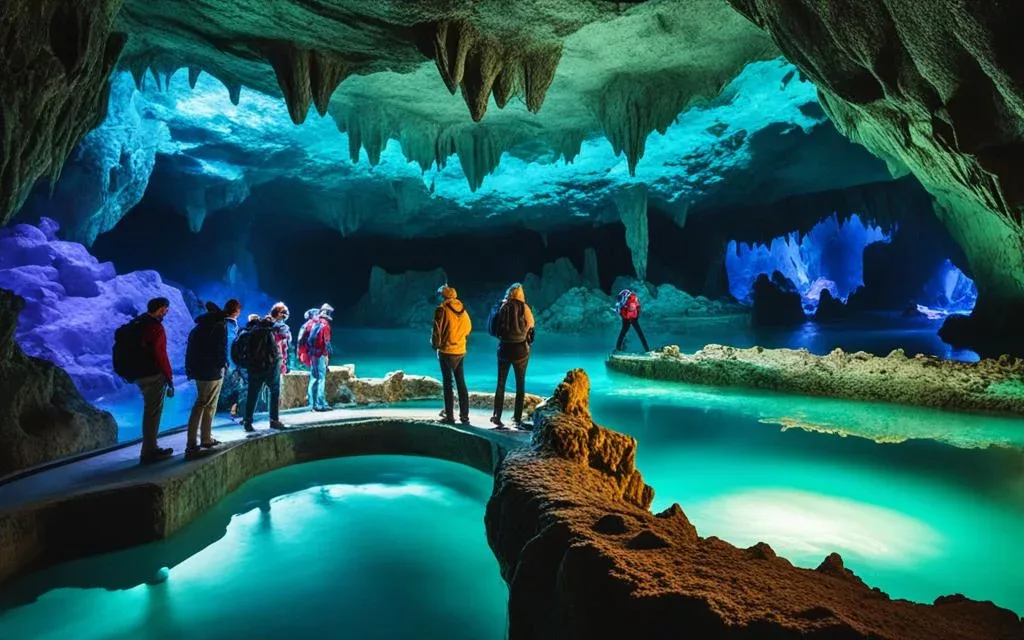
The cave is full of wonders, like huge limestone formations. There are also many unique features. You can find stalactites, stalagmites, and even underground rivers.
There are various tours to choose from. Each one shows you something special about the cave. Whether it’s the Frozen Niagara or Historic Tour, each is a cool adventure.
But there’s more to the park than the cave. You can hike, camp, and enjoy the stunning nature. The place is perfect for those who love the outdoors.
There are beautiful landscapes, forest trails, and great picnic areas. It’s a peaceful spot to enjoy nature and see different plants and animals. Plus, the Green River Valley adds to the park’s charm.
Kentucky is famous for its Bluegrass State title. It welcomes visitors with open arms. Besides exploring the cave and the park, you can enjoy local food and see the state’s equestrian culture. Kentucky is a place for unique and memorable experiences for all travelers.
Mammoth Cave’s Historical Significance
Mammoth Cave is famous for being the longest cave system known. But it’s also full of history that goes back thousands of years. Prehistoric American Indians were the first to explore its depth. They found its secret paths, making it an ancient wonder.
“Mammoth Cave is the grandest and most celebrated spectacle on earth…” – Stephen Bishop
Over time, many people played big roles in discovering Mammoth Cave. Stephen Bishop, an African American slave, was one of them. In the early 1800s, he guided visitors in the cave. His bravery and knowledge helped map new areas, adding to the cave’s wonder.
The Connection with Flint Ridge Cave System
In 1972, a historic event linked Mammoth Cave with Flint Ridge. It created the world’s longest cave system. This feat made Mammoth Cave even more extraordinary.
The link with Flint Ridge Cave opened new paths for exploration. It also showed how caves connect in an underground world. This discovery increased the wonder of Mammoth Cave.
Mammoth Cave means more than a natural wonder. It’s about brave exploration, the efforts of people like Stephen Bishop, and the ongoing search for underground secrets.
Conservation Efforts
Keeping Mammoth Cave’s history alive is a top priority. Many groups and individuals work hard to protect it. They make sure the cave’s ecosystems and unique features are preserved.
| Efforts | Goals |
|---|---|
| Monitoring cave conditions | To track changes and address any potential threats |
| Managing visitor impact | To minimize disturbances and preserve the cave’s natural state |
| Conducting research | To deepen our understanding of the cave’s geological and biological processes |
Conservation and careful tourism help preserve Mammoth Cave for the future. It will keep inspiring awe and leave a lasting impact on history.
Mammoth Cave’s International Recognition
| Mammoth Cave’s International Recognition |
|---|
|
Mammoth Cave National Park is known worldwide for its stunning cave system. It is valued for its great natural and cultural importance. In 1981, Mammoth Cave got added to UNESCO’s World Heritage list. It was recognized for being the largest cave system globally. And for its special caves and karst landscapes. This title shows its critical place in the study of the Earth’s past. The park covers 909,328 acres, including local counties. It is part of the Mammoth Cave Biosphere Region. This area works to boost local economies and culture. It also aims to save water and protect plant and animal life. In 2021, the park was named an International Dark Sky Park. This honor shows its work in preserving the night and dealing with light pollution issues. Since 2009, Mammoth Cave National Park has linked with other parks around the world. These sister park programs help share knowledge about preserving caves and living in harmony with the environment. The Green and Nolin Rivers Blueway was named Kentucky’s first National Water Trail in 2021. This recognition is part of a national system for protecting and enjoying waterways. The park’s many awards and partnerships highlight its beauty and importance. These achievements show it is a treasure that belongs to everyone. |
Other Longest Known Caves in the World
Mammoth Cave stands among the longest caves known, but it’s not alone. There are many other caves that are equally impressive. These places include Sistema Ox Bel Ha in Mexico, Shuanghedong Cave Network in China, and Jewel Cave in the U.S.A.
Systema Ox Bel Ha in Quintana Roo, Mexico, is a top underwater cave system. It’s known for its many underwater paths. This makes it both unique and difficult to explore.
“The underwater caves of Sistema Ox Bel Ha are a hidden paradise, where divers can witness stunning limestone formations and encounter a diverse array of marine life.”
The Shuanghedong Cave Network in China is over 60 miles long. It’s famous for its amazing stalactite and stalagmite formations. Spelunkers and photographers love to visit this cave.
In South Dakota, Jewel Cave is the third longest cave known. It’s a labyrinth filled with shiny calcite crystals. This is how the cave got its name.
These amazing caves show us just some of Earth’s hidden wonders. Exploring them offers a look into the beauty beneath our feet.
| Cave Name | Location | Length |
|---|---|---|
| Sistema Ox Bel Ha | Mexico | Longest underwater cave system in the world |
| Shuanghedong Cave Network | China | Over 60 miles (97 km) |
| Jewel Cave | United States | Third-longest cave in the world |
| … | … | … |
Mammoth Cave System’s Growth Potential
Mammoth Cave is the longest known cave system, with over 426 miles (686 km) of passages. Yet, we don’t know its full size. Despite its massive length, there are still areas to explore. Thanks to groups like the Cave Research Foundation, new sections are being found. This means Mammoth Cave might get even longer.
People from all walks of life come to explore Mammoth Cave. They map new parts, possible making it longer. This ongoing work proves Mammoth Cave is a vast, ever-growing underground world.
For those daring enough, Mammoth Cave offers the thrill of finding something new. Explorers dream of discovering fresh chambers and stunning natural wonders. The joy of caving lies in finding what’s hidden deep below.
| Mammoth Cave System | Other Known Cave Systems |
|---|---|
| Over 426 miles (686 km) of surveyed passageways | Varies from several miles to over 100 miles |
| Longest known cave system in the world | Multiple caves compete for the title of the second and subsequent longest caves |
| Continued exploration and mapping efforts | Exploration ongoing, but lengths subject to change |
| Potential for further growth | Growth potential varies depending on cave system |
Mammoth Cave stands out as a top global attraction. It’s known for its unique rocks, plants, and fascinating history. As a UNESCO World Heritage Site, it’s a place of great cultural importance. The park around it also offers fun outdoor activities for everyone to enjoy.
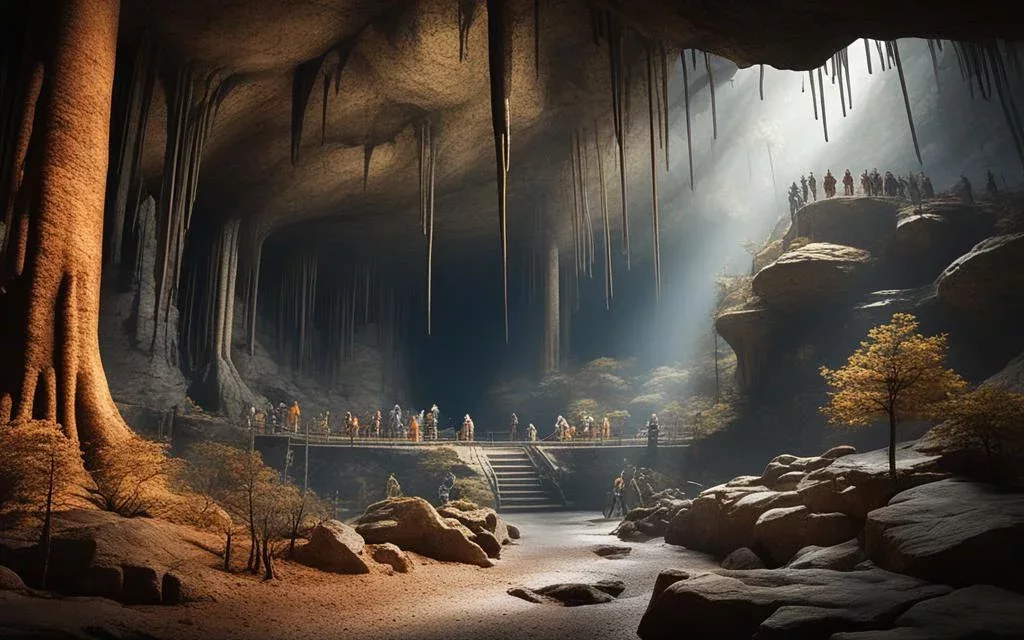
“Mammoth Cave is a testament to the continuous exploration and discovery that awaits those who venture into its depths.”
Mammoth Cave’s potential is endless, offering new wonders with every discovery. Every new passage adds to its impressive length. This phenomenon leaves explorers and scientists in awe, showcasing nature’s boundless beauty and mystery.
Conclusion
Mammoth Cave is a true wonder in our world, known as the longest cave system. People from long ago until now have been exploring its depths. This journey shows how much we love to find out what’s hidden underground.
Thanks to Mammoth Cave National Park, we can still see this amazing cave. The park works hard to protect it. This way, the cave’s beauty can still touch the hearts of those who visit it.
Despite what we know, Mammoth Cave’s full length remains a mystery. Explorers hope to find more hidden rooms and paths. For anyone keen on science, adventure, or nature, Mammoth Cave is a place full of endless surprises and inspiration.

